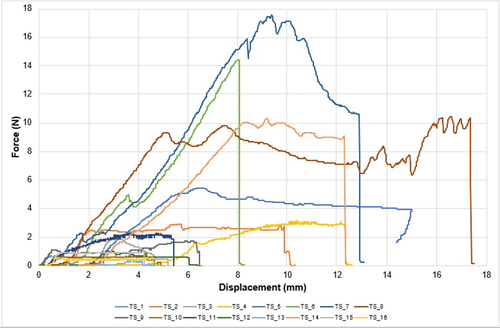Sutures and knots resistance to traction: an in vitro study
07IG1 ePOSTER BASIC RESEARCH
Background: Wound closure is a crucial factor in GBR procedures. The most used knot is the surgical knot, ensured by a third single throw. Several errors can occur when performing knots. The most common are the granny knot (GK), where the difference lays in the direction of the loose ends and the slipknot (SK), created when the loose end of the second throw are pulled in the wrong direction when closing. Both errors are alleged to compromise the resistance to traction of the knots.
Aim/Hypothesis: The aim of this study was to investigate whether knots performed with several errors and using several gauges can bare tensions before loosening or breaking.
Materials and Methods: In this preliminary test, nylon 4.0 and 5.0 were used. Sixteen knot variables were tested once, combining every example of error with both suture gauges (Fig 1). All the knots were inserted into ad hoc supports mounted on a MTS Synergie 200H (MTS Systems) testing maCHINA, equipped with a 100 N load cell. All the tests were performed at room temperature in displacement control at 5 mm/min rate, up to a maximum value of 20 mm. The evolution of the tightening force was monitored during the whole procedure.
Results: Results of the test are shown in Figure 2. All the tests led to the loosening of the knots, except for the TS_6 sample where the wire broke before detecting the knot loosening after about 8 mm tension: in this case it is possible to notice the absence of a force plateau (Figure 2, green line), which is characteristic of the loosening phase of all the other tests. A great variability is detected in the maximum force and displacement values reached by the tested samples. The maximum peak of tightening force at 17.5 N is reached by TS_7, while the maximum displacement of 17.32 mm belongs to TS_8. TS_14 and TS_5 knots failed between 6 and 10 N. Every other knot became loose at forces lower to 4 N, showing early displacements at failure.
Conclusions and Clinical Implications: Correct execution of knots is not a common topic in literature. Thus the need to investigate at which tension and displacement different sutures can prevent complications. Literature reports that with residual tension greater than 5 g (0.05N) there is minimal wound dehiscence risk, with 25 g (0.24 N) there is high risk. This preliminary study shows significative difference in tensile strength between the surgical knot, the GK and the SK. The results of this paper confirm the need of new studies.
Keywords: Implantology, Sutures, Traction, Basic research






